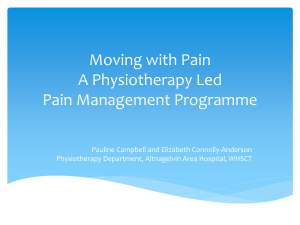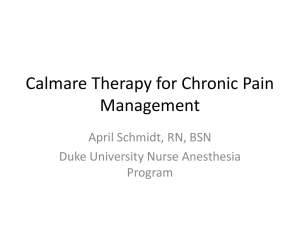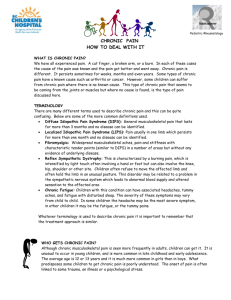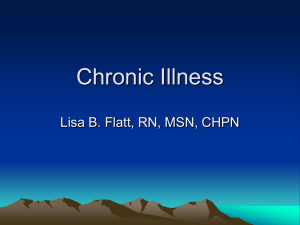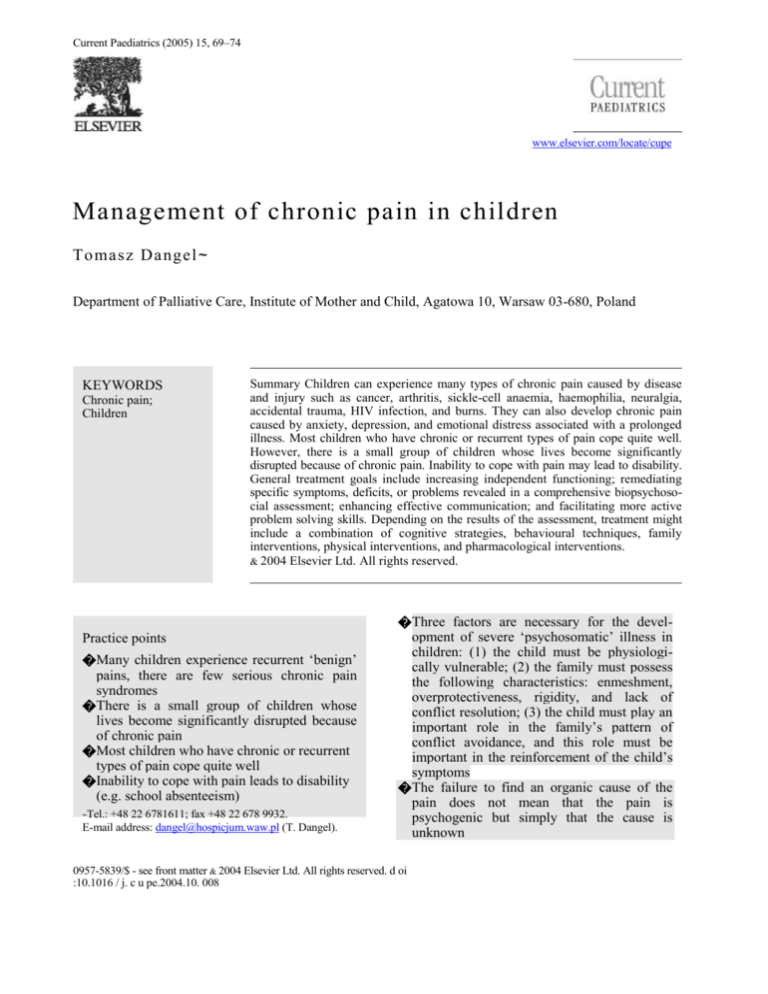
Current Paediatrics (2005) 15, 69–74
www.elsevier.com/locate/cupe
Management of chronic pain in children
To masz Da ngel ~
Department of Palliative Care, Institute of Mother and Child, Agatowa 10, Warsaw 03-680, Poland
KEYWORDS
Chronic pain;
Children
Summary Children can experience many types of chronic pain caused by disease
and injury such as cancer, arthritis, sickle-cell anaemia, haemophilia, neuralgia,
accidental trauma, HIV infection, and burns. They can also develop chronic pain
caused by anxiety, depression, and emotional distress associated with a prolonged
illness. Most children who have chronic or recurrent types of pain cope quite well.
However, there is a small group of children whose lives become significantly
disrupted because of chronic pain. Inability to cope with pain may lead to disability.
General treatment goals include increasing independent functioning; remediating
specific symptoms, deficits, or problems revealed in a comprehensive biopsychosocial assessment; enhancing effective communication; and facilitating more active
problem solving skills. Depending on the results of the assessment, treatment might
include a combination of cognitive strategies, behavioural techniques, family
interventions, physical interventions, and pharmacological interventions.
& 2004 Elsevier Ltd. All rights reserved.
Practice points
�Many children experience recurrent ‘benign’
pains, there are few serious chronic pain
syndromes
�There is a small group of children whose
lives become significantly disrupted because
of chronic pain
�Most children who have chronic or recurrent
types of pain cope quite well
�Inability to cope with pain leads to disability
(e.g. school absenteeism)
~Tel.:
+48 22 6781611; fax +48 22 678 9932.
E-mail address: dangel@hospicjum.waw.pl (T. Dangel).
�Three factors are necessary for the development of severe ‘psychosomatic’ illness in
children: (1) the child must be physiologically vulnerable; (2) the family must possess
the following characteristics: enmeshment,
overprotectiveness, rigidity, and lack of
conflict resolution; (3) the child must play an
important role in the family’s pattern of
conflict avoidance, and this role must be
important in the reinforcement of the child’s
symptoms
�The failure to find an organic cause of the
pain does not mean that the pain is
psychogenic but simply that the cause is
unknown
0957-5839/$ - see front matter & 2004 Elsevier Ltd. All rights reserved. d oi
:10.1016 / j. c u pe.2004.10. 008
70
Dangel
�Pharmacological approaches to chronic pain
management, except cancer pain, have
limited effectiveness
�Multidisciplinary approach is fundamental in
chronic pain management
In t r o d u c t i o n
Chronic pain has been recognized as that pain which
persists past the normal time of healing. 1 In practice
this may be less than 1 month, or more often, more
than 6 months. With non-malignant pain, 3 months is
the most convenient point of division between acute
and chronic pain, but for cancer pain, 3 months is too
long to wait before regarding a pain as chronic. The
definition related to the time of normal healing is not
sufficient. Many syndromes are treated as examples
of chronic pain although normal healing has not
occurred.2
Children can experience many types of chronic
pain caused by disease and injury such as cancer,
arthritis, sickle-cell anaemia, haemophilia, neuralgia,
accidental trauma, HIV infection, and burns. They
can also develop chronic pain caused by anxiety,
depression, and emotional distress associated with a
prolonged illness.3
It is useful to distinguish between the common
recurrent ‘benign’ pains of childhood and the less
common forms of chronic persistent pain. A large
proportion of otherwise healthy children experience
recurrent episodes of non-specific headache, chest
pain, abdominal pain, or limb pains. The art of
general paediatric practice lies in distinguishing
these unpleasant but essentially benign problems
from those symptoms that suggest more serious
illness.4
Crue5 distinguishes four types of long-term pain
from varying sources and with different coping
effectiveness:
T.
the disability, or the child’s pain far exceeds the
known cause.
Most children who have chronic or recurrent types
of pain cope quite well. However, there is a small
group of children whose lives become significantly
disrupted because of chronic pain. McGrath et al.6
estimated that chronic non-malignant pain with
disability occurs in less than 10% of children who
have a pain disorder, i.e. about 1% of the paediatric
population.
According to McGrath et al.6 seven explanatory
models can be applied to the syndrome of chronic
non-malignant pain with disability: family functioning, modelling, depression, coping with stress,
reinforcement, somatization disorder, and central
nervous system pain mechanisms.
Family functioning
Family overinvolvement and enmeshment of parents
in the lives of their children, which tend to be
expressed in excessive caregiving and control over
the adolescent’s behaviour, may cause chronic
benign intractable pain syndrome. This pattern is
often evident in the initial clinical interview when
questions addressed to the child are repeatedly
answered by the parent. Minuchin et al.7 suggested
that three factors are necessary for the development
of severe ‘psychosomatic’ illness in children. First,
the child must be physiologically vulnerable.
Second, the family must possess the following
characteristics: enmeshment, overprotectiveness,
rigidity, and lack of conflict resolution. Finally, the
child must play an important role in the family’s
pattern of conflict avoidance, and this role must be
important in the reinforcement of the child’s
symptoms. Several factors in combination can
produce parental overinvolvement: presence of
long-term pain; at least one parent who is overinvolved (i.e. very sympathetic and domineering);
the other parent must be collaborating in the
overinvolvement or be absent physically or emo1. Recurrent acute pain—refers to pain from
tionally; finally, the child or adolescent must be
underlying recurrent or continued nociceptive
unassertive in dealing with the pain and his or her
input (e.g. migraine or arthritis).
parents.
2. Ongoing acute pain—refers to pain from malignant disease.
3. Chronic benign pain—refers to ongoing pain with M o d e l l i n g
no known nociceptive input but with adequate
Modelling may influence the development of chronic
coping.
4. Chronic benign intractable pain syndrome (i.e. non-malignant pain with disability in several ways.
chronic non-malignant pain with disability, ac- Children may learn from their parent’s specific pain
cording to McGrath et al.)6—pain can be of syndromes, avoidance behaviour, the tendency to
unknown origin; it is long lasting and interferes, attend to pain sensations,
in a major way, with the child’s life; there is no
pathological organic process that can account for
Management of chronic pain in children
71
poor coping skills, and the value of pain as source of
reinforcement.
2.
Depression
Depression may be seen as the result of having a
longstanding pain disorder or as the initial condition
generating pain as a symptom.
Stressful life events
Stressful life events may precipitate recurrent pain.
Children who are not coping well with pain may not
only experience more stressful situations, but are
likely to precipitate more stressful events in their
lives.
3.
Reinforcement of pain behaviour
4.
This may be an important factor in maladaptive
coping with pain.
Somatization disorder
5.
This refers to a psychiatric disorder in which the
patient reports a large number of physical symptoms
that have interfered with everyday life and for which
no organic cause can be found. Children who have
numerous widespread or changing pain symptoms
without specific physical findings, who are missing
school, and whose parents have similar types of
problems, are at risk of developing serious problems,
including somatization disorder.
6.
Central nervous system pain mechanisms
Although a complete understanding of the neurophysiology of pain has not yet emerged, it may be
that chronic non-malignant pain with disability is, in
part, due to changes in functioning neurophysiology.
7.
M a n a ge me n t o f c h r oni c n o n -ma l i gn a n t
pain
8.
Clinical guidelines for the management of chronic
non-malignant pain with disability according to
McGrath et al. are:6
9.
1. Begin psychosocial assessment as soon as non- 10.
coping occurs. Children who are not attending
school regularly or who are curtailing their social
activities because of pain are not coping.
Assessment consists mostly of interviewing,
record keeping (e.g. pain diary), and observation
of the interaction among family members.
Unless the cause of the pain is clearly evident,
avoid the organic/psychogenic dichotomy. Most
chronic non-malignant pain of childhood cannot
be diagnosed as either organic or psychogenic
and is of unknown origin. The failure to find an
organic cause of the pain does not mean that the
pain is psychogenic but simply that the cause is
unknown. A finding of psychological causation
cannot rule out organic factors or vice versa.
Use the least intrusive methods possible. Simple
treatments such as reassurance and brief training
in coping strategies should precede extensive
psychological therapy, and outpatient therapy
should be thoroughly tried before inpatient
treatment is attempted.
Emphasize coping rather than curing. Children
should be encouraged to engage in as many
activities as they can that do not result in
physical harm or debilitating levels of pain.
Analgesics may be helpful, however, they do not
provide a solution to the problem.
Focus on family strengths. The strengths of each
family will vary. In one family, enmeshment can
be reframed into closeness. In another family,
strong identification with a parent can be used to
model coping behaviour, or rebellion can be
constructively channelled.
Investigate the school situation. A child who is
not coping with chronic non-malignant pain may
have a number of school-related stresses that
could be triggering avoidance behaviour and
non-coping pain behaviour. On the other hand, a
child may be succeeding in school but have an
overwhelming fear of failure. Telephone calls to
the child’s teacher may reveal serious stresses.
Private discussions with the child may uncover
hidden problems.
Teach coping skills. For example: total and
partial muscle relaxation, self-hypnosis, deep
breathing, cognitive and behavioural distraction,
thought stopping, positive self-talk, problem
solving, and assertiveness.
Listen to the patient. Never doubt patients’
statements that they are in pain.
Do not blame the patient or family. Blaming the
patient may be a response to our own frustration
and inability to help. Some chronic pain patients
may be skilled in triggering such responses.
Educate about pain. Knowledge can make the
family and child feel they in a stronger position
to discuss their situation with health professionals, it can correct misconceptions about
70
Dangel
pain, and help to form an alliance with the
doctor.
11. Understand without pitying. There is no place in
chronic pain for self-pity. Tender loving care and
extra attention for pain is appropriate when the
pain is acute but is destructive for the patient
who is not coping with chronic pain. Positive
and firm expectations set by the health
professional can provide a model for parents and
hope for the child. Unrealistic goals will only
encourage failure and future avoidance of
attempts to cope effectively may lead families to
drop out of therapy because of discouragement.
Bursch et al.8 introduced a concept of painassociated disability syndrome, which describes a
subset of patients with chronic pain with common
and severe difficulties in functioning, regardless of
the location or cause of their pain. It is a model of
disability that can help the clinician shift focus to a
rehabilitation model of care while avoiding dichotomization of the pain as physical or psychological.
Rather, it is assumed that all pain is physically
mediated with biologic, psychologic, and social
factors maintaining it. Disability in the above
definition refers to school absenteeism and/or severe
restriction of functioning in other activities. To meet
the criteria for pain-associated disability syndrome,
the severe disability has to have been present for at
least 2 months. General treatment goals include:
increasing independent functioning; remediating
specific symptoms, deficits, or problems revealed in
a comprehensive biopsychosocial assessment;
enhancing effective communication; and facilitating
more active problem solving skills. Depending on
the results of the assessment, treatment might include
a combination of cognitive strategies, behavioural
techniques,
family
interventions,
physical
interventions, and pharmacological interventions.
Unfortunately, in situations when psychological
treatment could be helpful, it is seldom available.
Many psychologists do not understand the complexities of significant pain, and few clinicians have a
psychological orientation.9
Pharmacological approaches to chronic pain
management in both adults and children have limited
effectiveness. Treatment of chronic pain in children
is based on extrapolation from experience with
adults, limited controlled trials, surveys, and
physicians’ preferences. Therefore, clinicians often
have to prescribe medications despite the lack of
efficacy data or approval for paediatric use.10
Recurrent abdominal pain is experienced by
approximately 5% of children and refers primarilyto
a condition in which children who are otherwise
medically well suffer episodes of pain interspersed
with pain-free periods. A subgroup of these children
T.
has recognizable causes, such as constipation, lactose
intolerance, uretero-pelvic junction obstruction,
inflammatory bowel disease, endometriosis, or
gastro-oesophageal reflux. Another subgroup has
been hypothesized to have visceral hyperalgesia or
visceral neuropathic pain. A major component of the
therapeutic approach involves the education of
patients and parents regarding the fact that these
pains do not imply serious or progressive illness, and
that continued participation in school and normal
activities will not cause harm. Cognitive-behavioural
treatment approaches are emphasized.
Pharmacological treatments such as fibre
supplementation, anti-cholinergics, sedatives, and
tricyclic antidepressants have been tried, but there
are comparatively few controlled trials.11
Recurrent headaches are experienced by 5–10% of
school-aged children. The most common types are
migraine and tension headaches. As with abdominal
pains, most children cope well with them and they do
not produce disability. The subgroup of children
referred to pain clinics are commonly those with
very severe pain episodes or those who have
assumed a pattern of disability and school
absenteeism. Many of the drugs commonly used for
prophylaxis or interruption of migraine episodes
have recently undergone clinical trials in children,
including magnesium, ibuprofen, acetaminophen,
sumatriptan, flunarizine, trazodone, and propranolol.
Cognitive-behavioural treatments, return to school,
and lifestyle interventions are emphasized. For
example, education on how to improve sleep hygiene
may result in reduction in the frequency of migraine
episodes.11
Sickle cell anaemia may be associated with both
recurrent acute severe pain and chronic persistent
pain. The dominant pain is that associated with
unpredictable and relentless vaso-occlusive episodes.
Pain management should integrate pharmacologic,
cognitive-behavioural and psychologic, and physical
approaches within a supportive framework.12,13
Musculoskeletal pains are experienced by 15% of
all school-age children. This group comprises
chronic arthritis, juvenile primary fibromyalgia
syndrome, back pain, knee pain, growing pains, and
overuse injuries.
Neuropathic pain is due to abnormal excitability in
the peripheral or central nervous system that may
persist after an injury heals or inflammation
subsides.2 The pain is often described as burning or
stabbing and may be associated with cutaneous
Management of chronic pain in children
hypersensitivity (allodynia). Neuropathic pain conditions in childhood are not rare, and are often
unrecognized by physicians.11
Phantom pain is defined as pain referred to a
surgically removed limb or portion thereof.2 Krane
and Heller14 found a 92% prevalence of phantom
pain in paediatric amputees. Pre-emptive analgesia
has not consistently prevented postoperative phantom limb pain.15 Large-scale surveys of amputees
show the ineffectiveness of treatments for phantom
limb pain that fail to address its underlying
mechanisms. Mechanism-based treatments were
relatively effective in a few small studies. Pharmacological and behavioural treatments resulting in
vasodilatation of the residual limb helped the
burning component of phantom limb pain but not
other features. Treatments to decrease muscle
tension in the residual limb reduced cramping, but
not other features.16,17
Complex Regional Pain Syndrome Type I(CRPS I),
also known as reflex sympathetic dystrophy, is a
syndrome that usually develops after an initiating
noxious event, is not limited to the distribution of a
single peripheral nerve, and is apparently disproportionate to the inciting event. It is associated at
some point with evidence of oedema, changes in skin
blood flow, abnormal sudomotor activity in the
region of the pain, allodynia or hyperalgesia. The site
is usually the distal aspect of an affected extremity or
with a distal to proximal gradient.2 As Berde and
Kuttner11 pointed out, treatments for CRPS I have
followed the aphorism ‘if your only tool is a hammer,
the whole world looks like a nail’. Historically,
anaesthetists performed sympathetic blocks;
rheumathologists recommended steroids; physical
therapists prescribed physiotherapy; neurologists
prescribed anticonvulsants, beta blockers or alpha
blockers;
surgeons
performed
operative
sympathectomy, and psychologists have recommended cognitive-behavioural treatment or psychotherapy, etc. Comparatively few treatments have
received controlled trials. More comprehensive
reviews have been published elsewhere.18
Chronic cancer pain may be cancer-related or
therapy-related. Cancer-related pain is caused by the
natural history of the tumour and may present as
bone pain, soft tissue or organ pain, and neuropathic
pain. Examples of therapy-related chronic pain
include phantom pain, neuropathy secondary to
vincristine or irradiation of a nerve plexus, prolonged
post-lumbar puncture headache, pain due to
mucositis or dermatitis, and others.19 Although the
principles of cancer pain management in children
have been well-established,20 cancer pain is still
inadequately treated in children. Wolfe et al.21
recently showed that 89% of children whodied from
cancer in Boston between 1990 and 1997 suffered
from pain during their last month of life. According
73
to the parents, treatment of pain was successful only
in 27% of cases.
Pain is the most frequent symptom in children
with life-limiting conditions who require palliative
care. The author’s experience is based on 254
children with malignant and non-malignant lifelimiting conditions, the patients of the Warsaw
Hospice for Children, who were treated at home
during the terminal phase of disease between 1994
and 2004. The cancer group (n=133) consisted of 66
children with solid tumours, 39 children with brain
tumours, and 28 children with leukaemia. The
average time of home care in the malignant group
was 50 days. Pain was experienced by 96% of
children with cancer during this period. Paracetamol
(1st step of the WHO analgesic ladder) was used in
49%, tramadol (2nd step of the WHO analgesic
ladder) was used in 68%, and strong opioids (3rd step
of the WHO analgesic ladder) were used in 63% of
the cancer patients. Pain rated as moderate to severe
(i.e. required treatment with strong opioid) was
experienced by 76% of children with solid tumours,
46% of children with brain tumours, and 61% of
children with leukaemia. In the group with
non-malignant life-limiting conditions (n=121), the
prevalence of pain was 71 %, however, only 6% of
children experienced pain rated as moderate to
severe and required strong opioids. The average time
of home care in the nonmalignant group was 447
days.
We evaluated the effectiveness of our palliative
home care programme. Parents’ primary expectation
was that the programme would relieve their
children’s suffering. Hospice services appeared
effective in this regard, as most parents felt that their
children died at home peacefully and free from
suffering. Additionally, parents felt their children’s
symptoms were well managed. Parents also noted a
range of understandable psychological stresses such
as helplessness, fear, and emotional exhaustion. The
results suggest that the hospice program was limited
in its effectiveness in reducing parental
psychological distress. Naturally, not all components
of human suffering can be eliminated and it is likely
that some aspects of suffering are so personal and
individual that hospice services cannot affect any
significant change. Even so, levels of satisfaction
with hospice services indicate that, despite their
suffering, parents appreciated and benefited from the
hospice care.22
The author’s opinion, despite the results obtained
by Wolfe et al.21, is that cancer pain in children can
be successfully controlled in the terminal phase in
the majority of cases. In the
70
Dangel
T.
6.
7.
Figure 1 Effective symptom management and consecutive
new aspects (‘faces’) of suffering—a ‘multi-curtain
effect’.
upper mentioned group, only one patient out of 133
required terminal sedation because of refractory pain
and inadequate pain control. He was a 3-yearold boy
dying of rhabdomyosarcoma of the nose and pharynx.
The factors which are crucial for effective pain
control are: home setting, fast access to a pain
specialist 24 h a day, nurses experienced in palliative
care, reliable and continuous pain assessment,
availability of advanced pain management techniques (e.g. PCA, epidurals, TENS) at home, and
methadone as a drug of choice in refractory cancer
pain.
However, freedom from pain is not necessarily
synonymous with freedom from suffering at the end
of life. Suffering is not directly related to the severity
of unrelieved physical symptoms. It is experienced
and can occur in relation to any aspect of the
patient’s life—physical, psychological, social, or
spiritual. A sense of loss of meaning and purpose,
helplessness, hopelessness, endlessness, and lack of
control are major causes of suffering.23 Sometimes,
especially in adolescents, effective pain management
leads to the discovery of new (hidden) aspects of
suffering (see Fig. 1).
8.
9.
10.
11.
12.
13.
14.
15.
16.
17.
18.
References
1.
2.
3.
4.
5.
Bonica JJ, editor. The management of pain. Philadelphia: Lea
& Febiger; 1953.
Merskey H, Bogduk N, editors. Classification of chronic
pain. Seattle: IASP Press; 1994.
McGrath PA. Psychological aspects of pain perception. In:
Schechter NL, Berde CB, Yaster M, editors. Pain in infants,
children, and adolescents. Baltimore: Wiliams & Wilkins;
1993. p. 39–63.
Greco CD, Berde CB. Pain management in children. In:
Behrman RE, Kliegman RM, Jenson HB, editors. Nelson
textbook of pediatrics. Philadelphia: W.B. Saunders Company;
2000. p. 306–12.
Crue BL. Foreword. In: Arnoff GM, editor. Evaluation and
treatment of chronic pain. Baltimore: Urban & Schwarzen berg; 1985. p. xv–xxi.
19.
20.
21.
22.
23.
McGrath PJ, Unruh AM, Branson SM. Chronic nonmalignant
pain with disability. In: Tyler DC, Krane EJ, editors. Advances
in pain research and therapy: pediatric pain. New York: Raven
Press; 1990. p. 255–71.
Minuchin S, Baker L, Rosman B, Liebman R, Milman L,
Todd T. A conceptual model of psychosomatic illness in
children: family organization and family therapy. Arch Gen
Psychatry 1975; 32:1031 –8.
Bursh B, Joseph MH, Zeltzer LK. Pain-associated disability
syndrome. In: Schechter NL, Berde CB, Yaster M, editors.
Pain in infants, children, and adolescents. Philadelphia:
Lippincott Williams & Wilkins; 2003. p. 841–8.
McGrath P, Finlay A. Chronic and recurrent pain in children
and adolescents. In: McGrath P, Finlay A, editors. Chronic
and recurrent pain in children and adolescents. Seattle: IASP
Press; 1999. p. 1–4.
Sethna NF. Pharmacotherapy in long-term pain: current
experience and future direction. In: McGrath P, Finlay A,
editors. Chronic and recurrent pain in children and
adolescents. Seattle: IASP Press; 1999. p. 243–66.
Berde C, Kuttner L. Chronic pain in children—an update. In:
The 5th International Symposium on Paediatric Pain (Educa tion Day). London: ISPP; 2000.
Schechter NL. The management of pain in sickle cell disease.
In: McGrath P, Finlay A, editors. Chronic and recurrent pain
in children and adolescents. Seattle: IASP Press; 1999. p.
99–114.
Dampier C, Shapiro BS. Management of pain in sickle cell
disease. In: Schechter NL, Berde CB, Yaster M, editors. Pain
in infants, children, and adolescents. Philadelphia: Lippincott
Williams & Wilkins; 2003. p. 489–516.
Krane EJ, Heller LB. The prevalence of phantom sensation
and pain in pediatric amputees. J Pain Symptom Manage
1995;10:21–9.
Nikolajsen L, Ilkjaer S, Christensen JH, et al. Randomized
trail of epidural bupivacaine and morphine in prevention of
stump and phantom pain in lower limb amputation. Lancet
1997;350:353–7.
Sherman RA. What do we really know about phantom limb
pain? Pain Rev 1994;1:261–74.
Flor H, Birbaumer N, Sherman RA. Phantom limb pain. Pain
Clin Updates 2000;VIII(3):1–4.
Dangel T. Chronic pain management in children. Part II:
reflex
sympathetic
dystrophy.
Paediatr
Anaesth
1998;8:105–12.
Miser AW, Miser JS. The treatment of cancer pain in
children. Schechter NL, editor. Pediatric clinics of North
America, vol. 36. Philadelphia: W. B. Saunders Company;
1989. p. 979–99.
Cancer Pain Relief and Palliative Care in Children. World
health organization & international association for study of
pain. Geneva: WHO; 1998.
Wolfe J, Grier HE, Klar N, et al. Symptoms and suffering at
the end of life in children with cancer. N Engl J Med
2000;342:326–33.
Dangel T, Fowler-Kerry S, Karwacki M, Bereda J . An
evaluation of a home palliative care program for children.
Ambulatory Child Health 2000;6:101–14.
Twycross R, Lichter I. The terminal phase. In: Doyle D,
Hanks G, MacDonald N, editors. Oxford textbook of palliative
medicine. Oxford: Oxford University Press; 1998. p. 977–92.







